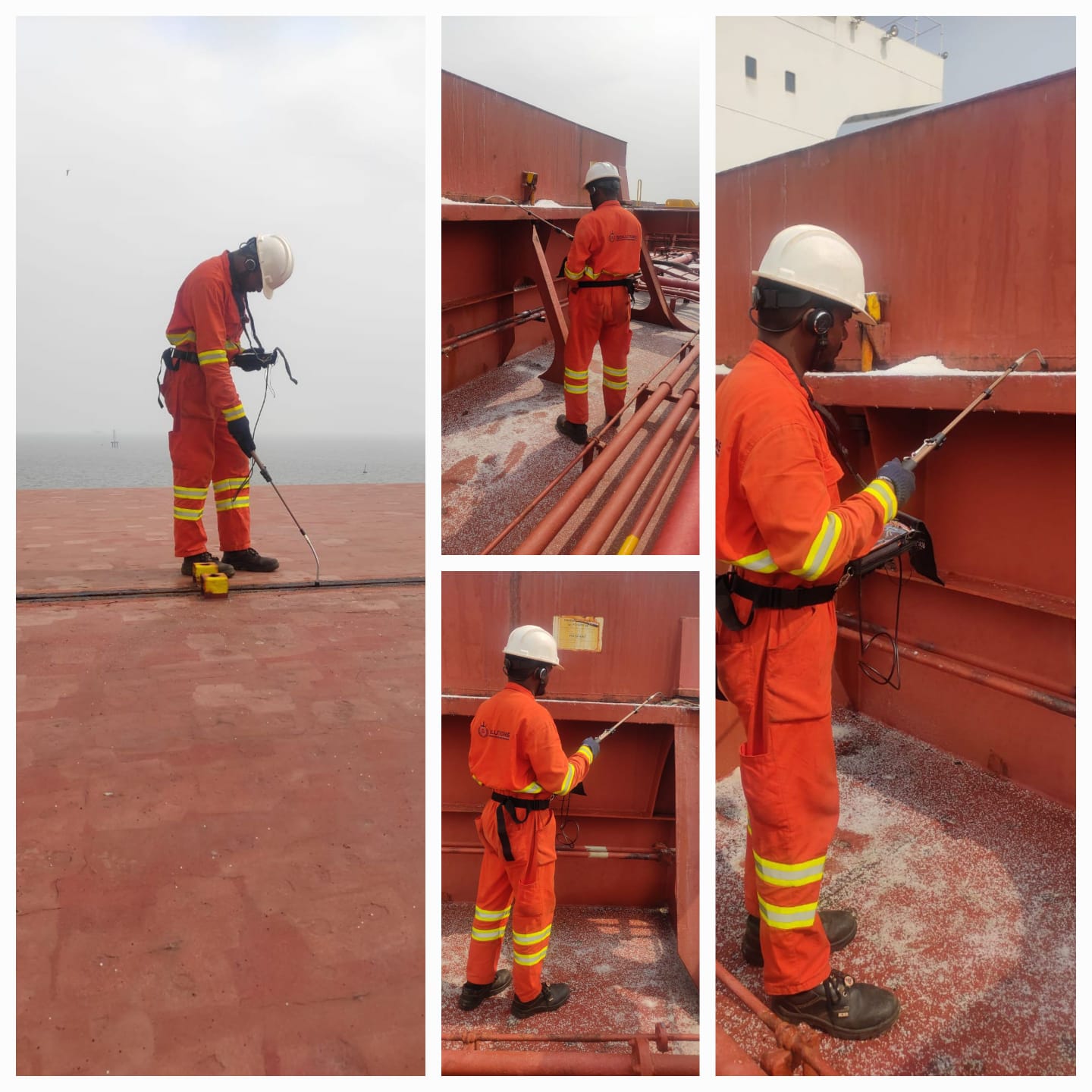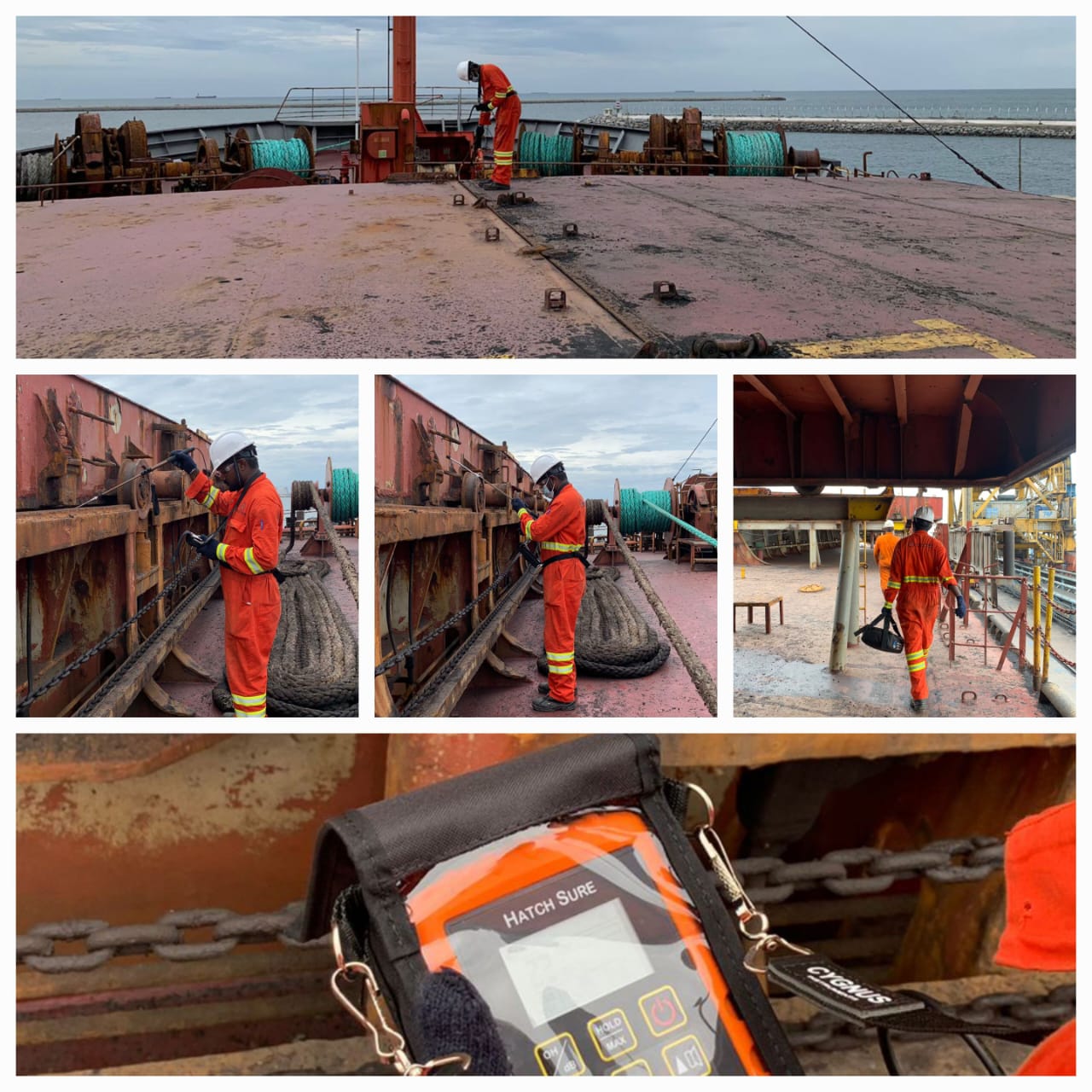HATCH COVER LEAK TESTING
HATCH COVER LEAK TESTING
To keep water out of the cargo holds of ships when they are at sea, hatch covers are utilized. Testing for hatch cover leaks is an essential step in guaranteeing the cargo’s and the ship’s safety throughout transit. Before the ship departs the port, the hatch cover is inspected to look for any leaks or flaws. There are a number of steps in the hatch cover leak testing process, and they can change based on the technique. Here is a general description of what happens:
The cargo hold must be empty prior to testing, and the hatch covers must be shut tightly. Additionally, the technician will make sure that any ventilation vents and other potential entry points for water are blocked.
On the basis of the ship’s specifications, its cargo, and other considerations, the technician will then select a testing method, such as water spray testing or ultrasonic testing.
If water spray testing is employed, the technician will use a hose to spray water onto the hatch cover while looking for any leaks. The specialist will utilize specialized tools to find any hatch cover flaws, including cracks or holes, if ultrasonic testing is employed.
The technician will thoroughly examine the hatch cover for any indications of leaks or flaws and will make any necessary measurements or observations.
The technician will next evaluate the findings to see whether any corrective action is required. If a leak or flaw is discovered, the expert will pinpoint its exact location, evaluate its seriousness, and suggest the best course of action for fixing it.
For future reference and compliance with marine legislation, the testing findings and any corrective measures will be noted.

Ultrasonic testing or water spray testing are frequently used to test for hatch cover leaks. Using a high-pressure hose, water is sprayed over the hatch cover in the Water Spray Testing procedure. The hatch cover would encounter pressure while on a cruise, so the water pressure is kept at a level that mimics that pressure. Normally, the water pressure is between 5 and 6 bars. Water will seep through any leaks in the hatch cover, giving away a problem. High-frequency sound waves are used in the non-destructive testing technique of ultrasonic testing to find flaws in materials.
This procedure involves scanning the hatch cover using a portable ultrasonic testing instrument. Sound waves from the device bounce back to it after passing through the hatch cover. The hatch cover’s imperfections or leaks will alter how the sound waves are reflected, enabling the technician to locate and assess the fault. These two approaches are dependable and frequently employed in the maritime sector. They work well at spotting leaks and flaws in hatch covers, which can help to avoid damage to cargo and ship mishaps.
Need for Hatch cover leak testing in Marine offshore inspection
As it helps to assure the safety of the ship and the cargo it transports during transit, hatch cover leak testing is a crucial component of marine offshore inspection. In marine offshore inspection, hatch cover leak testing is essential for the reasons listed below:
Hatch covers are made to keep water from getting into the cargo hold when a ship is in motion. Any cracks in the hatch cover that permit water to enter could endanger the cargo and cause the ship to become unsteady. Before the ship departs the port, hatch cover leak testing helps find any leaks or deficiencies in the hatch cover, lowering the danger of water intrusion.
Usually transported in containers or bulk carriers, cargo might be vulnerable to moisture damage. In order to ensure that the cargo is shielded from any water intrusion during transit and avoid damage or spoilage, hatch cover leak testing is performed.
A leaky hatch cover can allow water to enter, which might compromise the ship’s stability and perhaps lead to a capsize. Leak testing of the hatch cover assists in locating any leaks or flaws that could lead to instability, enabling corrective action to be conducted before the ship departs the port.
Testing for hatch cover leaks is mandated by several maritime rules and is done throughout the inspection process. Ship owners and operators can verify compliance with these rules and save potential penalties or fines by performing hatch cover leak testing.
Efficiency and precision of Hatch cover leak testing
The technique utilized and the technician’s experience both affect how effectively and precisely a hatch cover leak test is performed. A quick and easy approach to find leaks in the hatch cover is water spray testing. Although it might not be as accurate as ultrasonic testing, which can find even minor flaws in the hatch cover and give more specific information about their location and seriousness.
The results of ultrasonic testing can be more exact and precise but are more complex, requiring specialized equipment and skilled specialists. The decision between the two techniques depends on a number of variables, including the type of ship, the cargo, and the resources at hand. Both techniques have advantages and disadvantages. In order to provide accurate and trustworthy results, hatch cover leak testing calls for meticulous attention to detail and skill. Hatch cover leak testing, when done properly, can greatly increase the effectiveness and safety of sea transportation.

Applications and benefits of Hatch cover leak testin
In the marine business, hatch cover leak testing has several uses and advantages. Testing for hatch cover leaks is frequently used to make sure that the cargo is delivered safely and without suffering from water damage or other deterioration. For sensitive goods like food, chemicals, or electronics, this is especially crucial. Testing for hatch cover leaks also aids in finding any flaws or holes that can compromise the ship’s stability. In turn, this lowers the possibility of maritime mishaps and contributes to the crew and passengers’ safety. Additionally, maritime regulations frequently call for the testing of hatch cover leaks, and ship owners and operators must abide by these rules to avoid penalties or fines. Minimizing cargo damage and spoilage, lowering the danger of maritime accidents, and assuring compliance with laws are all advantages of hatch cover leak testing.
Scope and Significance of Hatch cover leak testing
In the marine business, hatch cover leak testing has several uses and advantages. Testing for hatch cover leaks is frequently used to make sure that the cargo is delivered safely and without suffering from water damage or other deterioration. For sensitive goods like food, chemicals, or electronics, this is especially crucial. Testing for hatch cover leaks also aids in finding any flaws or holes that can compromise the ship’s stability. Ultrasonic testing or water spray testing can be used for this testing, which is usually carried out before the ship departs the port. Testing for hatch cover leaks is important since it guards against cargo damage and guarantees the crew and ship’s safety while traveling. Before the ship sets sail, corrective action can be made if a leak or fault is found, averting potential maritime mishaps or disasters.
Additionally, maritime regulations frequently mandate hatch cover leak testing, assuring compliance and lowering the possibility of fines or penalties. In order to protect the safety of the ship and its cargo during transportation, maintain ship stability, and adhere to regulatory standards, hatch cover leak testing is essential in marine offshore inspection. In order to provide accurate and trustworthy results, hatch cover leak testing is a crucial procedure that calls for meticulous attention to detail and skill. In order to ensure the security and effectiveness of marine transportation, proper testing can aid in preventing water infiltration, cargo damage, and maritime mishaps.
Why NDT and PHWT solutions
A business called NDT and PHWT Solutions is focused on offering the maritime sector high-quality hatch cover leak testing services. The business employs a group of skilled experts who have received the most recent testing methodology training and certification, guaranteeing the precision and dependability of their services. The following are some of the methods used by NDT and PHWT Solutions to offer top-notch hatch cover leak testing services:
Technicians with years of experience in hatch cover leak testing work for NDT and PHWT Solutions. They are very knowledgeable about the testing procedures, tools, and techniques needed to find even the tiniest leaks and flaws in the hatch cover.
Modern tools are used by NDT and PHWT Solutions to guarantee the precision and accuracy of their tests. Their ultrasonic testing apparatus undergoes routine calibration and maintenance to guarantee accurate results.
To meet the needs of various clients, NDT and PHWT Solutions provides a variety of testing techniques, such as water spray testing and ultrasonic testing. They carefully collaborate with clients to choose the best testing strategy based on the requirements of the ship, the cargo, and other elements.
Technicians at NDT and PHWT Solutions are rigorous in their testing, closely examining every square inch of the hatch cover for indications of leakage or flaws. In order to guarantee the accuracy of their findings, they also take exact measurements and keep meticulous records of their observations.
NDT and PHWT Solutions is dedicated to abiding with all pertinent maritime laws. They make sure that their testing procedures adhere to the necessary requirements and stay up to date with the most recent regulations.
In general, NDT and PHWT Solutions offers excellent hatch cover leak testing services that are precise, dependable, and catered to their clients’ demands. They are a dependable partner for ship owners and operators who wish to guarantee the security and effectiveness of their maritime transportation because of their knowledge, tools, attention to detail, and dedication to compliance.
ultrasonic leak detector able to perform a quick and effective evaluation of cargo hold hatch covers and door seals to determine water leaks and weather tightness.
For More Information Contact Our Expert Team: support@solutionss.org

